Answered step by step
Verified Expert Solution
Question
1 Approved Answer
no more than 2 pages Discussion Questions Considering the current financial state of Barnes & Noble, its accelerated executive turnover in the past four years,
no more than 2 pages 

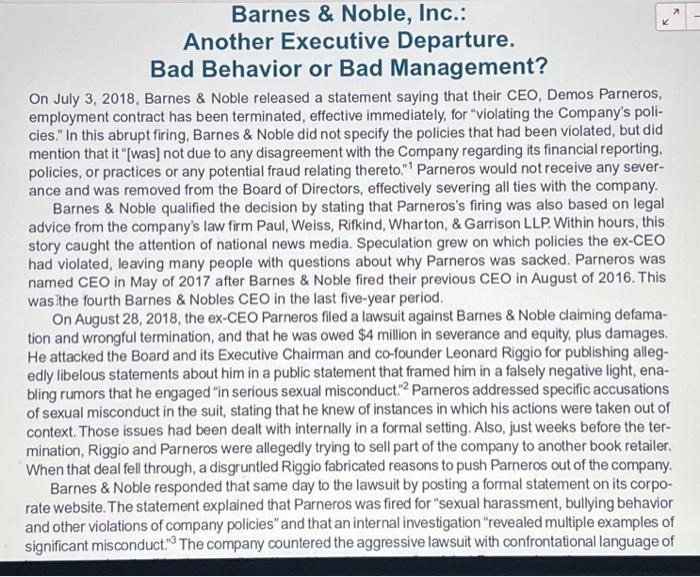


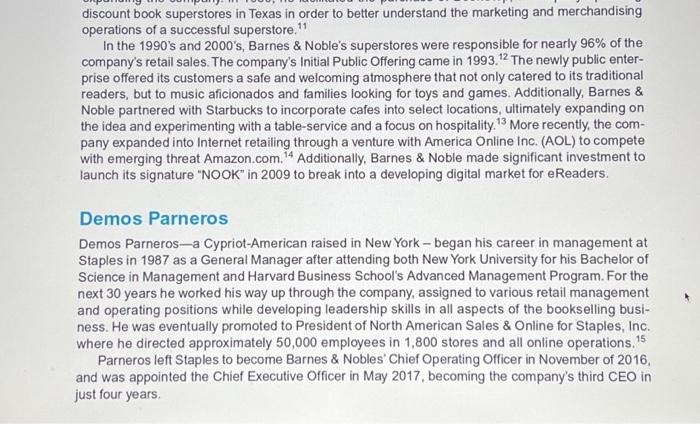


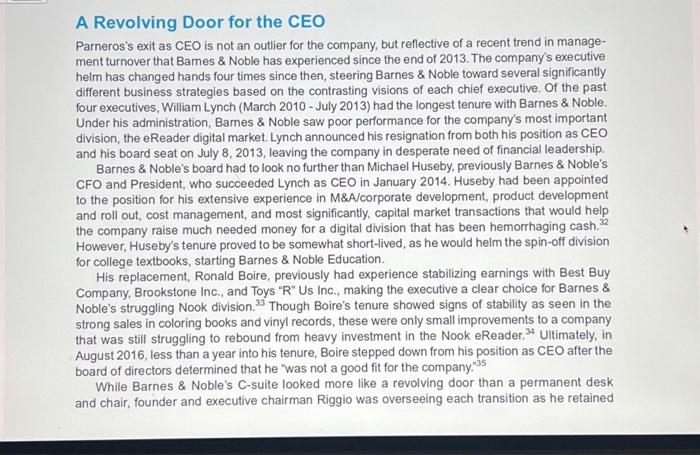
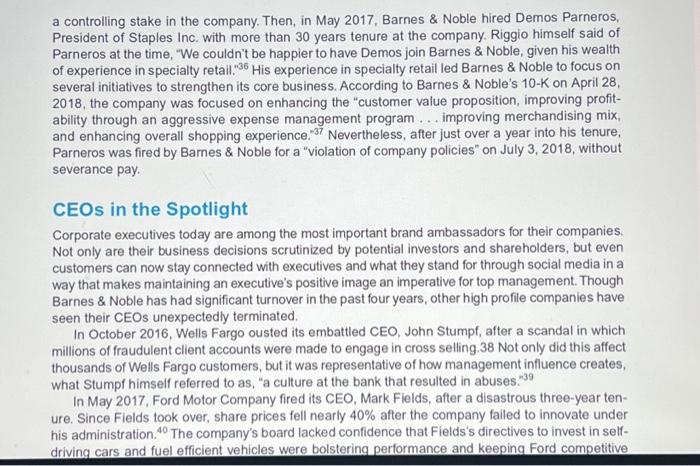

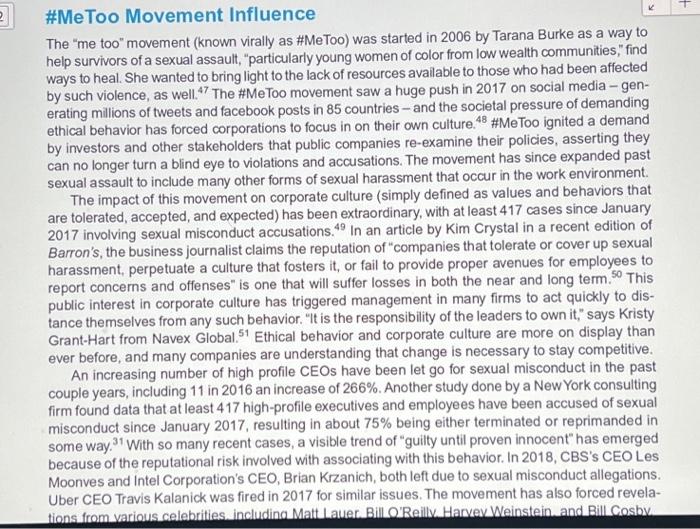
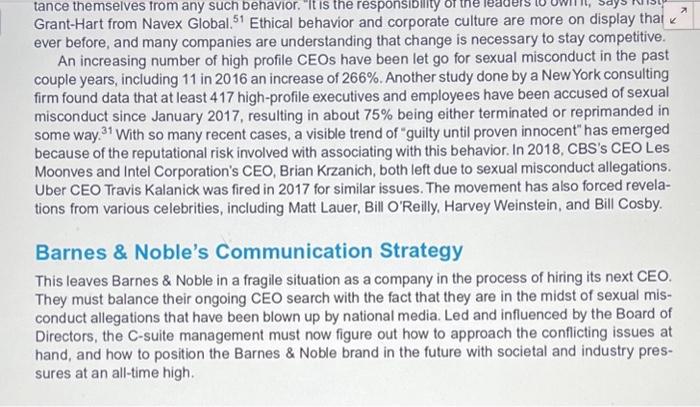
Discussion Questions Considering the current financial state of Barnes \& Noble, its accelerated executive turnover in the past four years, and its status as a defendant in the lawsuit with its ex-CEO: 1. How does a company respond to allegations of sexual misconduct against employees and executives whether they are corroborated in the lawsuit or not? Should management address Barnes \& Noble's culture and its workplace environment? 2. How does a company with substantial executive turnover stabilize revenues across its most vulnerable divisions and draft a strategy for the future? 3. Should Barnes \& Noble retain the investments they have made in their NOOK division or retail locations? 4. How should this company and its Board of Directors respond and position themselves as they defend against litigation over wrongful termination and defamation of character? On July 3, 2018, Barnes \& Noble released a statement saying that their CEO, Demos Parneros, employment contract has been terminated, effective immediately, for "violating the Company's policies." In this abrupt firing, Barnes \& Noble did not specify the policies that had been violated, but did mention that it "[was] not due to any disagreement with the Company regarding its financial reporting, policies, or practices or any potential fraud relating thereto." Parneros would not receive any severance and was removed from the Board of Directors, effectively severing all ties with the company. Barnes \& Noble qualified the decision by stating that Parneros's firing was also based on legal advice from the company's law firm Paul, Weiss, Rifkind, Wharton, \& Garrison LLP. Within hours, this story caught the attention of national news media. Speculation grew on which policies the ex-CEO had violated, leaving many people with questions about why Parneros was sacked. Parneros was named CEO in May of 2017 after Barnes \& Noble fired their previous CEO in August of 2016. This was the fourth Barnes \& Nobles CEO in the last five-year period. On August 28, 2018, the ex-CEO Parneros filed a lawsuit against Barnes \& Noble claiming defamation and wrongful termination, and that he was owed $4 million in severance and equity, plus damages. He attacked the Board and its Executive Chairman and co-founder Leonard Riggio for publishing allegedly libelous statements about him in a public statement that framed him in a falsely negative light, enabling rumors that he engaged "in serious sexual misconduct." 2 Parneros addressed specific accusations of sexual misconduct in the suit, stating that he knew of instances in which his actions were taken out of context. Those issues had been dealt with internally in a formal setting. Also, just weeks before the termination, Riggio and Parneros were allegedly trying to sell part of the company to another book retailer. When that deal fell through, a disgruntled Riggio fabricated reasons to push Parneros out of the company. Barnes \& Noble responded that same day to the lawsuit by posting a formal statement on its corporate website. The statement explained that Parneros was fired for "sexual harassment, bullying behavior and other violations of company policies" and that an internal investigation "revealed multiple examples of significant misconduct. 3 The company countered the aggressive lawsuit with confrontational language of had violated, leaving many people with questions about why Parneros was sacked. Parneros was named CEO in May of 2017 after Barnes \& Noble fired their previous CEO in August of 2016. This was the fourth Barnes \& Nobles CEO in the last five-year period. On August 28, 2018, the ex-CEO Parneros filed a lawsuit against Barnes \& Noble claiming defamation and wrongful termination, and that he was owed $4 million in severance and equity, plus damages. He attacked the Board and its Executive Chairman and co-founder Leonard Riggio for publishing allegedly libelous statements about him in a public statement that framed him in a falsely negative light, enabling rumors that he engaged "in serious sexual misconduct."2 Parneros addressed specific accusations of sexual misconduct in the suit, stating that he knew of instances in which his actions were taken out of context. Those issues had been dealt with internally in a formal setting. Also, just weeks before the termination, Riggio and Parneros were allegedly trying to sell part of the company to another book retailer. When that deal fell through, a disgruntled Riggio fabricated reasons to push Parneros out of the company. Barnes \& Noble responded that same day to the lawsuit by posting a formal statement on its corporate website. The statement explained that Parneros was fired for "sexual harassment, bullying behavior and other violations of company policies" and that an internal investigation "revealed multiple examples of significant misconduct." The company countered the aggressive lawsuit with confrontational language of its own, arguing the litigation was "an attempt to extort money" and that Parneros's actions were "unacceptable and not representative of the high standards 44 that Barnes \& Noble expects of its employees. History of Barnes \& Noble Barnes \& Noble, as it exists today, is a "modern" version of the company. Originally established in 1873, the enterprise was the idea of Charles M. Barnes, who hoped to become a book seller in Wheaton, Illinois. He was succeeded in 1917 by his son William Barnes, who partnered with Clifford Noble, moving the business to New York City, establishing their flagship store on Fifth Avenue at 18 th Street. The company readily established itself as a premier provider of everything from trade books to academic textbooks. 5 Since the company's historic inception, it had transferred ownership within the Barnes family until its retail and wholesale divisions were purchased by the conglomerate Amtel in 1966.6 Under Amtel, several years of declining business performance pushed the conglomerate to sell Barnes \& Noble to Leonard Riggio, an outside buyer. Leonard Riggio is credited as the "modern-day" founder of Barnes \& Noble when he acquired the company from Amtel in 1971 for only $750,000.' Riggio's innovative approach to book sales would prove to be transformative for the company. In the 1970s, Barnes \& Noble became the first bookseller to advertise on television, with a memorable "Of course! Of course!" commercial slogan. 8 Riggio took a bold and innovative step for Barnes \& Noble by selling New York Times best sellers at a discount from traditional publisher prices, establishing a 40,000 square foot "Sale Annex" next to the flagship store, effectively modeling the prototype for Barnes \& Noble's future superstore concept. Additionally, taking a page out of Sears' famous marketing strategy, Riggio developed a Barnes \& Noble mail order catalogue to reach customers across the U.S., elevating the company to a national brand. 9 The 1980's saw Barnes \& Noble undergo a period of significant expansion. The company's largest acquisition occurred in 1987 when Barnes \& Noble purchased B. Dalton Bookseller and its 797 stores from Dayton Hudson, establishing Barnes \& Noble as the premier nationwide retailer. 10As the second largest bookseller in America at the time, Riggio's strategy was to direct Barnes \& Noble toward a superstore concept loosely based on his original 40,000 foot "Sale Annex" as a means of expanding the company. In 1989, he facilitated the purchase of BookStop, a company operating discount book superstores in Texas in order to better understand the marketing and merchandising operations of a successful superstore. 11 In the 1990's and 2000's, Barnes \& Noble's superstores were responsible for nearly 96% of the company's retail sales. The company's Initial Public Offering came in 1993.12 The newly public enterprise offered its customers a safe and welcoming atmosphere that not only catered to its traditional discount book superstores in Texas in order to better understand the marketing and merchandising operations of a successful superstore. 11 In the 1990 's and 2000 's, Barnes \& Noble's superstores were responsible for nearly 96% of the company's retail sales. The company's Initial Public Offering came in 1993312 The newly public enterprise offered its customers a safe and welcoming atmosphere that not only catered to its traditional readers, but to music aficionados and families looking for toys and games. Additionally, Barnes \& Noble partnered with Starbucks to incorporate cafes into select locations, ultimately expanding on the idea and experimenting with a table-service and a focus on hospitality. 13 More recently, the company expanded into Internet retailing through a venture with America Online Inc. (AOL) to compete with emerging threat Amazon.com. 14 Additionally, Barnes \& Noble made significant investment to launch its signature "NOOK" in 2009 to break into a developing digital market for eReaders. Demos Parneros Demos Parneros-a Cypriot-American raised in New York - began his career in management at Staples in 1987 as a General Manager after attending both New York University for his Bachelor of Science in Management and Harvard Business School's Advanced Management Program. For the next 30 years he worked his way up through the company, assigned to various retail management and operating positions while developing leadership skills in all aspects of the bookselling business. He was eventually promoted to President of North American Sales \& Online for Staples, Inc. where he directed approximately 50,000 employees in 1,800 stores and all online operations. 15 Parneros left Staples to become Barnes \& Nobles' Chief Operating Officer in November of 2016. and was appointed the Chief Executive Officer in May 2017, becoming the company's third CEO in just four years. Form 8-K was established to require public companies to disclose non-financial material corporate changes to their investors. Before 2002, however, public companies were only required to report Form 8-K on a limited number of material changes and the law allowed them to wait for disclosure until the next periodic financial report. Consequently, investors would not know about changes in the company that could have materially affected their investment decisions until possibly months later. The Sarbanes-Oxley Act of 2002 strengthened Form 8-K under Section 409 of the Act, stating that public companies must disclose "on a rapid and current basis" (four days) any material corporate events to the SEC to protect and inform investors. 29 The events span nine broad categories, and include the "Departure of Directors or Certain Officers; Election of Directors; Appointment of Certain Officers; Compensatory Arrangements of Certain Officers" (full list can be found at https://www.sec. gov/fast-answers/answersform 8khtmhtml ). The 8-K is a legal document filed with the Securities and Exchange Commission. As such, companies are obligated to disclose all material information regarding a potentially market-moving event, otherwise the document could be used as evidence of failure to fully disclose. If a company phrases information in a way that is unclear, contradicts other statements, or omits information it could be a cause for further investigation. On July 3,2018 , the same day Parneros was sacked by Barnes \& Noble, the company filed a Form 8-K in accordance with the announcement of his termination. The statement: The Board of Directors of Barnes \& Noble, Inc. (NYSE: BKS) today announced the termination of its Chief Executive Officer, Demos Parneros, for violations of the Company's policies. This action was taken by the Company's Board of Directors who were advised by the law firm Paul, Weiss, Rifkind, Wharton \& Garrison LLP. Mr. Parneros' termination is not due to any disagreement with the Company regarding its financial reporting, policies or practices or any potential fraud relating thereto. Mr. Parneros will not receive any severance payment and he is no longer a member of the Company's Board of Directors. 30 The 8-K released immediately after Parneros's firing appears to be at odds with the company's later claim that Parneros was fired for sexual misconduct, as supported in their policy on personal behavior in the workplace in their "Code of Business Conduct \& Ethics": In addition, Barnes \& Noble prohibits harassing, retaliatory or discriminatory conduct in the workplace, whether based upon age, race, color, ancestry, national origin, citizenship status, military or veteran status, religion, creed, citizenship status, disability, sex, sexual orientation, marital status, genetic information, gender identity and expression, or any other unlawful basis. This includes sexual harassment, regardless of whether it is committed by supervisory or non-supervisory personnel or any other third party. 31 It seems unclear whether Barnes \& Noble's 8K referred directly to Parneros being dismissed for sexual misconduct. As Barnes \& Noble is legally required to disclose "all material information" regarding the event, not clarifying the nature of Parneros's firing could constitute a failure on Barnes & Noble's behalf to fully disclose to the public all material information that could affect the underlying value of company shares. Investors might interpret the phrase, "termination is not due to any disagreement with the Company regarding its financial reporting, policies or practices or any potential fraud relating thereto," as pointing at an internal conflict over business strategy rather than directly an issue of an executive's sexual misconduct. If that is correct, the question remains: Would public knowedge of Parneros's behavior have changed investors' perspectives about the valuation of the stock? A Revolving Door for the CEO Parneros's exit as CEO is not an outlier for the company, but reflective of a recent trend in management turnover that Bames \& Noble has experienced since the end of 2013. The company's executive helm has changed hands four times since then, steering Barnes \& Noble toward several significantly different business strategies based on the contrasting visions of each chief executive. Of the past four executives, William Lynch (March 2010 - July 2013) had the longest tenure with Barnes \& Noble. A Revolving Door for the CEO Parneros's exit as CEO is not an outlier for the company, but reflective of a recent trend in management turnover that Bames \& Noble has experienced since the end of 2013. The company's executive helm has changed hands four times since then, steering Barnes \& Noble toward several significantly different business strategies based on the contrasting visions of each chief executive. Of the past four executives, William Lynch (March 2010 - July 2013) had the longest tenure with Barnes \& Noble. Under his administration, Bames \& Noble saw poor performance for the company's most important division, the eReader digital market. Lynch announced his resignation from both his position as CEO and his board seat on July 8,2013 , leaving the company in desperate need of financial leadership. Barnes \& Noble's board had to look no further than Michael Huseby, previously Barnes \& Noble's CFO and President, who succeeded Lynch as CEO in January 2014. Huseby had been appointed to the position for his extensive experience in M\&A/corporate development, product development and roll out, cost management, and most significantly, capital market transactions that would help the company raise much needed money for a digital division that has been hemorrhaging cash. 32 However, Huseby's tenure proved to be somewhat short-lived, as he would helm the spin-off division for college textbooks, starting Barnes \& Noble Education. His replacement, Ronald Boire, previously had experience stabilizing earnings with Best Buy Company, Brookstone Inc., and Toys "R" Us Inc., making the executive a clear choice for Barnes \& Noble's struggling Nook division. 33 Though Boire's tenure showed signs of stability as seen in the strong sales in coloring books and vinyl records, these were only small improvements to a company August 2016, less than a year into his tenure, Boire stepped down from his position as CEO after the board of directors determined that he "was not a good fit for the company:" While Barnes \& Noble's C-suite looked more like a revolving door than a permanent desk and chair, founder and executive chairman Riggio was overseeing each transition as he retained a controlling stake in the company. Then, in May 2017, Barnes \& Noble hired Demos Parneros, President of Staples Inc. with more than 30 years tenure at the company. Riggio himself said of Parneros at the time, "We couldn't be happier to have Demos join Barnes & Noble, given his wealth of experience in specialty retail., 36 His experience in specialty retail led Barnes \& Noble to focus on several initiatives to strengthen its core business. According to Barnes \& Noble's 10-K on April 28 , 2018 , the company was focused on enhancing the "customer value proposition, improving profitability through an aggressive expense management program ... improving merchandising mix, and enhancing overall shopping experience. 37 Nevertheless, after just over a year into his tenure, Parneros was fired by Barnes \& Noble for a "violation of company policies" on July 3, 2018, without severance pay. CEOs in the Spotlight Corporate executives today are among the most important brand ambassadors for their companies. Not only are their business decisions scrutinized by potential investors and shareholders, but even customers can now stay connected with executives and what they stand for through social media in a way that makes maintaining an executive's positive image an imperative for top management. Though Barnes \& Noble has had significant turnover in the past four years, other high profile companies have seen their CEOs unexpectedly terminated. In October 2016. Wells Fargo ousted its embattled CEO, John Stumpf, after a scandal in which millions of fraudulent client accounts were made to engage in cross selling. 38 Not only did this affect thousands of Wells Fargo customers, but it was representative of how management influence creates, what Stumpf himself referred to as, "a culture at the bank that resulted in abuses." In May 2017, Ford Motor Company fired its CEO, Mark Fields, after a disastrous three-year tenure. Since Fields took over, share prices fell nearly 40% after the company failed to innovate under his administration. 40 The company's board lacked confidence that Fields's directives to invest in selfdriving cars and fuel efficient vehicles were bolstering performance and keeping Ford competitive In October 2016, Wells Fargo ousted its embattled CEO, John Stumpf, after a scandal in which millions of fraudulent client accounts were made to engage in cross selling. 38Not only did this affect thousands of Wells Fargo customers, but it was representative of how management influence creates. what Stumpf himself referred to as, "a culture at the bank that resulted in abuses.".39 In May 2017, Ford Motor Company fired its CEO, Mark Fields, after a disastrous three-year tenure. Since Fields took over, share prices fell nearly 40% after the company failed to innovate under his administration. 40 The company's board lacked confidence that Fields's directives to invest in selfdriving cars and fuel efficient vehicles were bolstering performance and keeping Ford competitive with other automakers in the market. In September 2017. Equifax CEO Richard Smith announced his retirement after a massive cybersecurity breach occurred, affecting the sensitive personal data of up to 143 million people. 41 In addition to the social security numbers, birth dates, and home addresses captured by the breach, Equifax is under multiple investigations with executives facing potential insider trading violations as reports show that executives sold "unusual amounts of stock before the breach was publicly disclosed. 2 In June 2018, Intel CEO Brian Krzanich was removed from office after it was revealed that he had a consensual sexual relationship with an employee. 43 Though consensual, Krzanich's activities were in direct violation of the company's non-fraternization policies. The board reaffirmed its stance on violations, stating in the company's press release that Intel holds the "expectation that all employees will respect [the company's] values and adhere to the company's code of conduct.".44 In September 2018. Tyson Foods CEO Tom Hayes stepped down from his executive position, citing "personal reasons" for his departure. 45 The company also released a statement on his behalf, asserting that "there are no issues of personal conduct or integrity.".46 While these are just a few high-profile examples of executive turnover, it is evident that regardless of tenure, CEO's are held to the highest standards of conduct by their companies and society. Media outlets are also quick to report on publicly traded companies and changes to their management, making CEO actions much more prominent. The "me too" movement (known virally as \#MeToo) was started in 2006 by Tarana Burke as a way to help survivors of a sexual assault, "particularly young women of color from low wealth communities," find ways to heal. She wanted to bring light to the lack of resources available to those who had been affected by such violence, as well.47 The \#MeToo movement saw a huge push in 2017 on social media - generating millions of tweets and facebook posts in 85 countries - and the societal pressure of demanding ethical behavior has forced corporations to focus in on their own culture. 48#MeToo ignited a demand by investors and other stakeholders that public companies re-examine their policies, asserting they can no longer turn a blind eye to violations and accusations. The movement has since expanded past sexual assault to include many other forms of sexual harassment that occur in the work environment. The impact of this movement on corporate culture (simply defined as values and behaviors that are tolerated, accepted, and expected) has been extraordinary, with at least 417 cases since January 2017 involving sexual misconduct accusations 49 In an article by Kim Crystal in a recent edition of Barron's, the business journalist claims the reputation of "companies that tolerate or cover up sexual harassment, perpetuate a culture that fosters it, or fail to provide proper avenues for employees to report concerns and offenses" is one that will suffer losses in both the near and long term. 50 This public interest in corporate culture has triggered management in many firms to act quickly to distance themselves from any such behavior. "It is the responsibility of the leaders to own it," says Kristy Grant-Hart from Navex Global. 51 Ethical behavior and corporate culture are more on display than ever before, and many companies are understanding that change is necessary to stay competitive. An increasing number of high profile CEOs have been let go for sexual misconduct in the past couple years, including 11 in 2016 an increase of 266%. Another study done by a NewYork consulting firm found data that at least 417 high-profile executives and employees have been accused of sexual misconduct since January 2017, resulting in about 75% being either terminated or reprimanded in some way." With so many recent cases, a visible trend of "guilty until proven innocent" has emerged because of the reputational risk involved with associating with this behavior. In 2018, CBS's CEO Les Moonves and Intel Corporation's CEO, Brian Krzanich, both left due to sexual misconduct allegations. Uber CEO Travis Kalanick was fired in 2017 for similar issues. The movement has also forced revelations from various celebrities including MattLauer. Bill O'Reillv. Harvev Weinstein and Bill Cosby Grant-Hart from Navex Global. 51 Ethical behavior and corporate culture are more on display that k ever before, and many companies are understanding that change is necessary to stay competitive. An increasing number of high profile CEOs have been let go for sexual misconduct in the past couple years, including 11 in 2016 an increase of 266%. Another study done by a New York consulting firm found data that at least 417 high-profile executives and employees have been accused of sexual misconduct since January 2017, resulting in about 75% being either terminated or reprimanded in some way. 31 With so many recent cases, a visible trend of "guilty until proven innocent" has emerged because of the reputational risk involved with associating with this behavior. In 2018, CBS's CEO Les Moonves and Intel Corporation's CEO, Brian Krzanich, both left due to sexual misconduct allegations. Uber CEO Travis Kalanick was fired in 2017 for similar issues. The movement has also forced revelations from various celebrities, including Matt Lauer, Bill O'Reilly. Harvey Weinstein, and Bill Cosby. Barnes \& Noble's Communication Strategy This leaves Barnes \& Noble in a fragile situation as a company in the process of hiring its next CEO. They must balance their ongoing CEO search with the fact that they are in the midst of sexual misconduct allegations that have been blown up by national media. Led and influenced by the Board of Directors, the C-suite management must now figure out how to approach the conflicting issues at hand, and how to position the Barnes \& Noble brand in the future with societal and industry pressures at an all-time high 












Step by Step Solution
There are 3 Steps involved in it
Step: 1

Get Instant Access to Expert-Tailored Solutions
See step-by-step solutions with expert insights and AI powered tools for academic success
Step: 2

Step: 3

Ace Your Homework with AI
Get the answers you need in no time with our AI-driven, step-by-step assistance
Get Started


